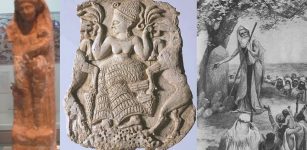Large Pre-Columbian Pyramid Discovered Under Highway In Mexico But It Will Not Be Excavated
Jan Bartek - AncientPages.com - In June, construction workers in Hidalgo, Mexico, were expanding the Pachuca-Huejutla highway when they stumbled upon an unexpected find. Beneath the surface lay something unusual that prompted archaeologists to investigate further. They soon discovered the remains of a large pyramid near San Miguel Metzquititlán, dating back to Mexico's pre-Columbian era.
This significant discovery was publicly announced on December 5 by Mexico’s Ministry of Culture and the National Institute of Anthropology (INAH) following a partial excavation.
View of “Structure 1” before reburial. Credit: INAH / CINAH Hidalgo.
According to INAH's press release, this pyramid, officially named Structure 1, stands over 1,000 feet tall and is part of a larger archaeological site featuring five sectors and at least ten mounds for temples that have not survived through time.
The site dates back to the Epiclassic (650-950 A.D.) and Late Postclassic (1350-1519 A.D.) periods. Initial investigations revealed obsidian fragments and rock paintings depicting faces and everyday objects—indicating an ancient citadel—and researchers collected 155 samples, including ceramics and lithic materials from floors made with lime, coal, earth, and charred wood for future laboratory analysis.
The artifacts and their location in the Sierra Alta region of Mexico provide compelling evidence for researchers to conclude that the pyramid was originally constructed during the Metzca rule. This multi-ethnic culture thrived in the area long before the arrival of the Spanish.
The stratigraphic profile of a pyramidal base was analyzed and reburied as a conservation measure. Credit: INAH / CINAH Hidalgo.
The pyramid measures between 300 to 400 meters in dimension. Héctor Labra Chávez from San Agustín Metzquititlán's tourism department noted that its base lies beneath where the road passes; thus, excavation is necessary for further understanding of this structure since no remnants of pre-Columbian civilizations are known in this area.
See also: More Archaeology News
However, INAH has stated that due to budget constraints excavation will not proceed further.
Labra mentioned that local government offered financial support if INAH could provide personnel but after sample collection INAH decided instead on preservation efforts: covering it with geotextile fabric before re-burying it along with plans for constructing a protective 43-meter wall around this historic site.
Written by Jan Bartek - AncientPages.com Staff Writer






















